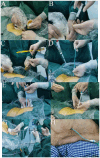PTCD and choledochoscopy for recurrent choledocholithiasis after multiple abdominal surgeries: a case report
- PMID: 39776841
- PMCID: PMC11703660
- DOI: 10.3389/fmed.2024.1466184
PTCD and choledochoscopy for recurrent choledocholithiasis after multiple abdominal surgeries: a case report
Abstract
Background: Special attention should be given to intra-abdominal adhesions in patients with a history of open cholecystectomy for gallstones or abdominal surgery. Choosing the appropriate surgical approach to remove the stones is crucial.
Patient summary: A 68-year-old male was admitted due to sudden onset of upper abdominal pain lasting more than 6 h. In 2018, he underwent open Billroth II surgery for gastric cancer at an external hospital, and in 2020, he underwent open cholecystectomy for gallstones. In August 2023, he received gamma knife treatment for recurrent gastric cancer brain metastasis at another hospital with good results. In December of the same year, the patient presented to our hospital due to recurrent common bile duct stones and cholangitis. Given his history of two abdominal surgeries, percutaneous transhepatic cholangiodrainage (PTCD) combined with choledochoscopic stone extraction was chosen, which was successful in completely removing the stones. A PTCD tube was left in place postoperatively.
Conclusion: For patients with a history of two or more abdominal surgeries who experience recurrent common bile duct stones, PTCD has the advantages of a shorter operative time, less blood loss, earlier postoperative ventilation, earlier resumption of eating, minimal trauma and faster recovery.
Keywords: case report; cholangitis; epigastric pain; gallbladder stones; history of multiple abdominal surgeries; percutaneous transhepatic cholangiodrainage.
Copyright © 2024 Li, Zeng, Li, Lu, Li and Zhang.
Conflict of interest statement
The authors declare that the research was conducted in the absence of any commercial or financial relationships that could be construed as a potential conflict of interest.
Figures



Similar articles
-
Successful treatment of percutaneous transhepatic papillary dilation in patients with obstructive jaundice due to common bile duct stones after Billroth II gastrectomy: report of two emergent cases.J Clin Gastroenterol. 2000 Jan;30(1):91-3. doi: 10.1097/00004836-200001000-00020. J Clin Gastroenterol. 2000. PMID: 10636221
-
Analysis of Wire-Guided Hemostasis Introducer for Percutaneous Therapy of Bile Duct Stones.Digestion. 2018;97(3):267-274. doi: 10.1159/000485179. Epub 2018 Feb 9. Digestion. 2018. PMID: 29428940
-
Emergency open surgery with a duodenotomy and successful removal of an impacted basket following a complicated endoscopic retrograde cholangiopancreatography procedure: a case report.J Med Case Rep. 2021 Feb 23;15(1):93. doi: 10.1186/s13256-020-02608-1. J Med Case Rep. 2021. PMID: 33618756 Free PMC article.
-
Single-stage laparoscopic common bile duct exploration and cholecystectomy versus two-stage endoscopic stone extraction followed by laparoscopic cholecystectomy for patients with gallbladder stones with common bile duct stones: systematic review and meta-analysis of randomized trials with trial sequential analysis.Surg Endosc. 2018 Sep;32(9):3763-3776. doi: 10.1007/s00464-018-6170-8. Epub 2018 Mar 30. Surg Endosc. 2018. PMID: 29603004
-
Mini-Invasive management of concomitant gallstones and common bile duct stones : where is the evidence ( Review article).Tunis Med. 2019 Aug-Sep;97(8-9):997-1004. Tunis Med. 2019. PMID: 32173848
References
-
- Premakrishna S, Gobishangar S, Nilojan JS, Vaikunthan G, Thirunavukkarasu J. Pneumo-peritoneum, pneumo-retroperitoneum and subcutaneous emphysema following endoscopic retrograde cholangiopancreatography with sphincterotomy-an uncommon complication case report. J Surg Case Rep. (2024) 2024:rjae415. doi: 10.1093/jscr/rjae415, PMID: - DOI - PMC - PubMed
Publication types
LinkOut - more resources
Full Text Sources

